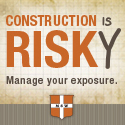
| www.agc.org • August 2018 |
Contact Us Archives
Subscribe Printer-Friendly AdvertiseSafety and HealthFacebook |
Leadership Skills to Turn Your Foremen into Jobsite Safety Leaders BY DR. LINDA M. GOLDENHAR, DIRECTOR OF RESEARCH AND EDUCATION
THE CENTER FOR CONSTRUCTION RESEARCH AND EVALUATION Foremen and lead workers who have the skills to be effective jobsite safety leaders are the linchpins to creating a strong jobsite safety climate — a key indicator of injury outcomes. Unfortunately, there is a shortage of needed safety leadership training. To help address this gap, CPWR - The Center for Construction Research and Training with funding from NIOSH, developed The Foundations for Safety Leadership (FSL); a two-and-a-half hour safety leadership training module designed to teach foremen and lead workers five critical safety leadership skills and how to put them into practice. Two key drivers led CPWR to recognize the need for such training. The first was discovered at a 2013 CPWR-NIOSH workshop where 70 construction stakeholders worked together and decided on eight key leading indicators of a strong jobsite safety climate, one being site supervisor safety leadership. The second came from a 2012 McGraw Hill — CPWR survey showing that many construction companies, regardless of size, require their new foremen to take the OSHA 30-hour to learn leadership skills. However, the OSHA 30-hour course didn’t have a leadership training module until the FSL became an official elective on January 1, 2017. Since then, over 10,000 workers have participated in the FSL and it has demonstrated it can meet the industry’s needs and desires. Two key drivers led CPWR to recognize the need for such training. The first was discovered at a 2013 CPWR-NIOSH workshop where 70 construction stakeholders worked together and decided on eight key leading indicators of a strong jobsite safety climate, one being site supervisor safety leadership. The second came from a 2012 McGraw Hill — CPWR survey showing that many construction companies, regardless of size, require their new foremen to take the OSHA 30-hour to learn leadership skills. However, the OSHA 30-hour course didn’t have a leadership training module until the FSL became an official elective on January 1, 2017. Since then, over 10,000 workers have participated in the FSL and it has demonstrated it can meet the industry’s needs and desires.  The likely benefits of your foremen and lead workers participating in the FSL training include:
Here are some typical comments from contractors’ whose foremen participated in the FSL training:
Trained foremen have also had a lot of positive feedback about skills they learned, particularly 3-way communication and engaging crew members:
If you want to incorporate the FSL into your ongoing training, you can download all of the teaching and supporting materials at no cost at https://www.cpwr.com/foundations-safety-leadership-fsl. If you send your foremen to the OSHA 30-hour course, encourage them to ask the trainer to teach the FSL as one of the electives. For more additional information about the FSL, you can contact the FSL project lead: Dr. Linda M. Goldenhar, director of research and evaluation at CPWR — The Center for Construction Research and Evaluation, at lgoldenhar@cpwr.com. |
|||
 2300 Wilson Boulevard, Suite 300 · Arlington, VA 22201 · 703-548-3118 (phone) · 703-548-3119 (fax) · www.agc.org
2300 Wilson Boulevard, Suite 300 · Arlington, VA 22201 · 703-548-3118 (phone) · 703-548-3119 (fax) · www.agc.org
About AGC | Advocacy | Industry Topics | Programs and Events | Career Development | News & Media
© Copyright 2025 The Associated General Contractors of America. All rights reserved.

